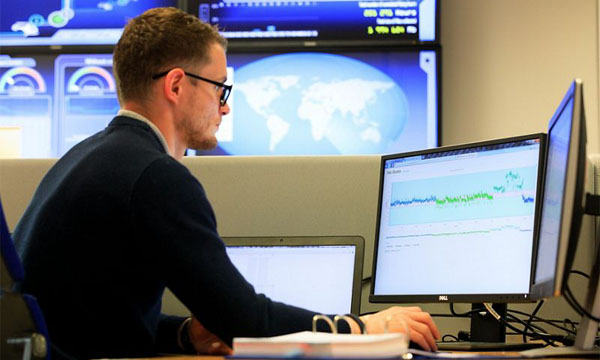Matthieu Louvot (Airbus Helicopters): "We are the first to offer digitising all operations" |
| Interview by Léo Barnier |
|
|
29 NOV 2018 | 1150 words
|
 |
Matthieu Louvot, Executive Vice President Customer Support & Services for Airbus Helicopters. © Airbus Helicopters |
|
|
|
Just like the current movement in fixed-wing aircraft, helicopter maintenance is developing alongside digital innovation. With the launch of products such as the Fleet Keeper digital logbook or the FlyScan data analysis tool last year or SmartForce, the equivalent of Skywise for the military sector, this year, Airbus Helicopters means to be proactive in this area. At Helitech we met Matthieu Louvot, Executive Vice President Customer Support & Services for Airbus Helicopters, who outlined the latest progress made by the European helicopter manufacturer.
You have signed agreements at Helitech with several maintenance software publishers with a view to exchanging data. What is the aim of these partnerships?
We know that all of our customers already have maintenance management systems and we don't want to impose one on them. Therefore, we have decided to certify four software publishers - MRX Systems, Rusada, Ramco and Traxxall - who will enable our customers to exchange data with us and with their machines, on different levels.
These publishers will be able to interface their maintenance software both with the data provided by the Helionix cockpits (modular avionics fitted as standard to all Airbus Helicopters twin-engine machines, ed.) and with our own systems in order to send us maintenance data. We will then be able to analyse it and propose connected services to our customers. Their software will also integrate the elements that we transmit, such as digitised documentation for a machine when it is delivered.
A customer will be able to digitise all their operations and work paperless on Airbus machines. We are the first in the helicopter sector, and I think even beyond, to really provide the possibility of doing this.
With these four agreements, what share of the fleet can you cover?
A major part, and this is just the start. The objective is to cover around 80% of the fleet by the end of the year, in favour of other agreements which will be signed soon. Our idea is to manage to cover the main operators on the market. Of course, we need them to want to partner us in this process. We want to both propose a choice to our customers with several Airbus-certified software applications and cover the largest fleets installed.
Is this type of service mainly targeted at large fleets?
The aim is to also target large operators, with partners who are able to address everyone with more or less sophisticated solutions depending on their size. For example, Traxxall proposes solutions which are adapted to small customers.
Do you want to connect this maintenance data to your various tools, such as Fleet Keeper?
These certified software applications will be able to speak to Airbus Helicopters, to machines and to systems such as Fleet Keeper or the digitised Log Card (registry file, ed.) which we will be proposing at the start of next year. The goal is to connect Fleet Keeper to all our systems so that it is supplied with all this data.
The advantage in interfacing everything is to eliminate many possible errors and omissions. It is therefore very important in terms of flight safety and traceability. It also saves time by avoiding having to copy data between systems by hand. Above all, as we connect data, this enables these famous analyses which will be an extra step in improving machine performance.
This will be the case with FlyScan, which currently analyses the vibration data collected by the Hums (health and usage monitoring sensors, ed.). We will be extending it to usage data, i.e. non-vibration data, and to maintenance data. This will open up possibilities for identifying flight profiles which generate additional fuel consumption or maintenance, for anticipating part removals during a future inspection in order to adapt stocks and reduce lead times, or even for detecting the main reliability difficulties which impact an aircraft's availability.
 Airbus Helicopters claims one AOG avoided per year and per machine thanks to HUMS data analysis. © Airbus Helicopters
Airbus Helicopters claims one AOG avoided per year and per machine thanks to HUMS data analysis. © Airbus Helicopters
As for FlyScan, it's been in place for a year now. Have you been able to measure its first operational returns?
It's been a bit less than that. We really started to market it at HAI Heli-Expo in February 2018 and we now have 45 machines under contract.
We've looked at the numbers and we estimate that we help each customer avoid at least one AOG per year and per machine, with around 7% savings on total maintenance load. This will increase as we collect more data and develop more algorithms. Everything still depends on the operator's initial situation: if they have a lot of last-minute breakdowns, the effect will be higher than for an operator who has fully optimised their maintenance. This also depends on the type of machine, the type of operation and so on. It's quite variable.
During Helitech, you announced nearly 550 helicopters and 146 customers connected to your different data services. What are your more long-term objectives?
Our objective is to reach 3000 connected machines within three years, for all services, with the same logic as currently: the ideal is to have the maintenance data, which enables the most rich service, but also the flight data. For a fleet of 12 000 machines, many of which are the old generation, this is quite a strong ambition.
Like Airbus Commercial Aircraft's Fomax unit, are you working on a data retrieval module?
We have a partnership with a Safran company, which proposes a unit that we call the HBox. It is a solution which collects data from machines which are not equipped with Helionix. It is already present on several hundred machines. We want to promote this solution together, which is highly accessible in terms of price, to equip the machines which do not currently have data collection systems.
Where are you in terms of setting up SmartForce for the military sector?
Several elements are coming together. We have already developed a certain number of algorithms which will be able to worn on both military and civilian data. We now have to develop the hosting platform with Defence & Space.
We know that there is significant interest from our French, German and Spanish customers in developing these systems, as well as from a certain number of foreign customers. Discussions are starting to determine what their expectations will be and how to manage the data flows, which will take a little time.
As these are important customers with specific requirements, we will be producing tailor-made solutions. Nevertheless, certain service bricks already exist and once we have the data we will be able to move forward quickly. Certain solutions may also be shared between fixed-wing and rotary platforms, between the A400M and certain helicopters, for example.
|
|
 |
Léo Barnier
Specialized journalist
Industry & Technology, Equipments, MRO
|
|
| |
They made this section possible |
|
|
|
|
|
|
|
|
|
|
|
|
|
|
|
|
Top stories |
|
|
|
|
|
Top stories
|